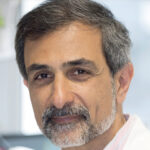Link to Pubmed [PMID] – 12441128
Exp Cell Res 2002 Nov; 281(1): 39-49
The satellite cell compartment provides skeletal muscle with a remarkable capacity for regeneration. Here, we have used isolated myofibers to investigate the activation and proliferative potential of satellite cells. We have previously shown that satellite cells are heterogeneous: the majority express Myf5 and M-cadherin protein, presumably reflecting commitment to myogenesis, while a minority is negative for both. Although MyoD is rarely detected in quiescent satellite cells, over 98% of satellite cells contain MyoD within 24 h of stimulation. Significantly, MyoD is only observed in cells that are already expressing Myf5. In contrast, a minority population does not activate by the criteria of Myf5 or MyoD expression. Following the synchronous activation of the myogenic regulatory factor+ve satellite cells, their daughter myoblasts proliferate with a doubling time of approximately 17 h, irrespective of the fiber type (type I, IIa, or IIb) from which they originate. Although fast myofibers have fewer associated satellite cells than slow, and accordingly produce fewer myoblasts, each myofiber phenotype is associated with a complement of satellite cells that has sufficient proliferative potential to fully regenerate the parent myofiber within 4 days. This time course is similar to that observed in vivo following acute injury and indicates that cells other than satellite cells are not required for complete myofiber regeneration.




